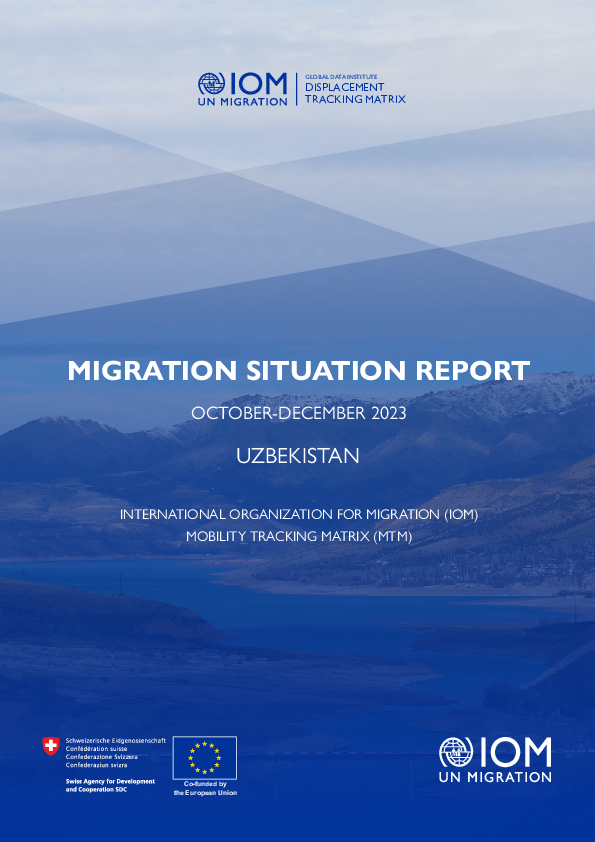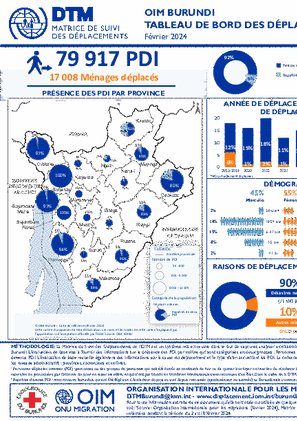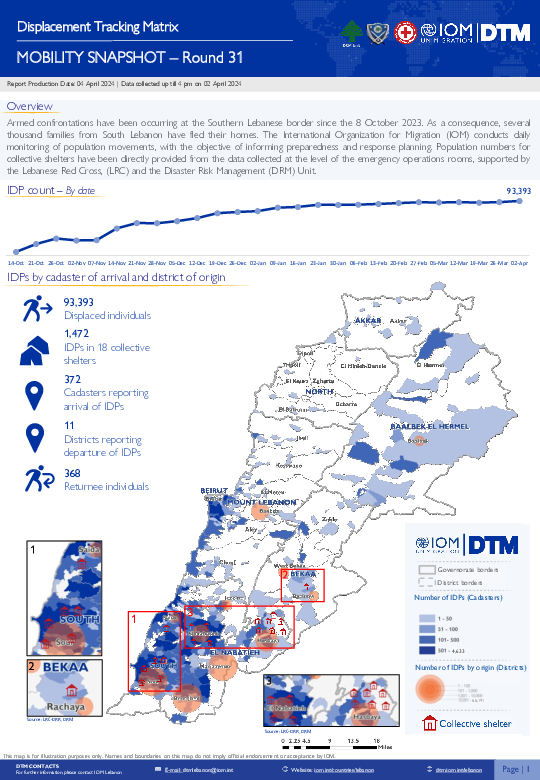-
Countries
-
Data and Analysis
-
Special Focus
-
Crisis Responses

Contact
DTM DRC, iomdrcdtm@iom.int
Language
English
Location
Democratic Republic of the Congo
Period Covered
Mar 14 2024
Mar 29 2024
Activity
- Mobility Tracking
- Event Tracking
In the eastern region of the Democratic Republic of Congo (DRC), particularly in North Kivu province, a prolonged and increasingly complex conflict persists, characterized by the presence of numerous armed groups, including the M23 group and the Congolese Armed Forces (FARDC) and their respective allies. Since the beginning of this year, the M23 has been advancing in the eastern part of the DRC, particularly towards Goma, which serves as the capital of North Kivu. Recent actions by the M23 suggest their intention to take control of Goma, potentially marking their second occupation of the city after a brief period of control in 2012.
Since the onset of the crisis, the International Organization for Migration (IOM), through the Displacement Tracking Matrix (DTM) continues to conduct a series of rapid assessments, including Emergency Tracking (EET/ERM), Crisis Analysis and
Registration activities, addressing immediate information needs with a view to understanding displacement dynamics and needs. This report presents the results of assessments carried out in the various displacement and return areas from 14 to 29 March 2024.

Contact
DTM DRC, iomdrcdtm@iom.int
Language
French
Location
Democratic Republic of the Congo
Period Covered
Mar 14 2024
Mar 29 2024
Activity
- Mobility Tracking
- Event Tracking
Dans la région orientale de la République démocratique du Congo (RDC), en particulier au Nord-Kivu, un conflit prolongé et de plus en plus complexe persiste. Ce conflit est caractérisé par la présence de divers groupes armés, y compris le groupe M23 et les Forces Armées Congolaises (FARDC), ainsi que leurs alliés respectifs. Depuis le début de cette année, le M23 a progressé dans la partie orientale de la RDC, notamment vers Goma, qui sert de capitale du Nord-Kivu. Les récentes actions entreprises par le M23 suggèrent leur intention de prendre le contrôle de Goma, marquant potentiellement leur deuxième occupation de la ville après une brève période de contrôle en 2012.
Depuis le début de la crise, l'OIM, par le biais de la matrice de suivi des déplacements (DTM) continue à mener une série d'évaluations rapides, y compris le suivi des urgences (EET/ERM), l'analyse des crises et enregistrement avec priorité de répondre aux besoins immédiats d'information en vue de comprendre la dynamique des déplacements et les besoins. Ce rapport présente les résultats des évaluations menées dans les différentes zones de déplacement et de retour du 14 au 29 mars 2024.

Contact
DTM Pakistan, DTMPakistan@iom.int
Language
English
Location
Pakistan
Period Covered
Mar 16 2024
Mar 31 2024
Activity
- Flow Monitoring
The International Organization for Migration (IOM) in Pakistan collects data on the outflows of Afghans at the Torkham (Khyber Pakhtunkhwa), Badini, Bahramcha and Chaman (Balochistan) border crossing points (BCPs) to better understand the movements of Afghans returning to Afghanistan. The data presented below is harmonised with those from the United Nations High Commissioner for Refugees (UNHCR), who also cover Ghulam Khan (Khyber Pakhtunkhwa). On 26 September 2023, the Ministry of Interior in Pakistan announced its decision to enact its “Illegal Foreigners’ Repatriation Plan (IFRP)”. Between 16 and 31 March 2024, 7,532 Afghan nationals returned to Afghanistan, including 5,057 through the Torkham BCP, 1,149 through the Chaman BCP, 1326 through the Ghulam Khan BCP, while no Afghan nationals returned through the Badini BCP. In addition, border authorities deported 74 individuals due to a lack of valid documentation. Since 1 January 2024, IOM identified 54,227 returns at the four BCPs.

Contact
iomtashkent@iom.int
Language
English
Location
Uzbekistan
Period Covered
Oct 01 2023
Dec 31 2023
Activity
- Flow Monitoring Survey
- Mobility Tracking
This current report presents the latest available data on recent trends concerning migration issues in Uzbekistan, drawing upon data available for October-December 2023 and bringing major findings for the whole previous year from national and international datasets that are available to the public. The report includes recent major global and regional events that significantly impacted the migration situation in the country. The continuing impacts of the Russian invasion of Ukraine on traditional migration corridors in the region, changing labour migration flows, increase of climate change and migration concerns, the growing urbanization process, the social-economic circumstances, increased irregular migration trends and other major events are described as main contributing factors of the human mobility and migratory movements in the given period in the country. The report also gives insights into capacity-building sessions on migration data, which were provided by IOM in Uzbekistan in the given period and introduces major improvements in this direction.
Contact
dtmlebanon@iom.int
Location
Lebanon
Activity
- Mobility Tracking
- Baseline Assessment
Period Covered
Oct 10 2023 -Mar 26 2024
Since October 8 there has been an increase in cross-border incidents between Israel and Lebanon, resulting in the displacement of people both within the South and elsewhere within the country. Since October 10, the Displacement Tracking Matrix (DTM) has been conducting the daily monitoring of population movements. The objective of the exercise is to inform preparedness and response planning.
Aggregated data is available through the DTM API: https://dtm.iom.int/data-and-analysis/dtm-api
A more detailed version of this dataset is available, to get access kindly click on the 'Request Access' button
Population Groups
IDPs
Survey Methodology
Unit of Analysis Or Observation
Admin Area 2
Admin Area 3
Household
Individual
Type of Survey or Assessment
Key Informant
Keywords
Geographical Scope Full Coverage
Administrative boundaries with available data
The current dataset covers the following administrative boundaries
Contact
dtmlebanon@iom.int
Location
Lebanon
Activity
- Mobility Tracking
- Baseline Assessment
Period Covered
Oct 10 2023 -Mar 19 2024
Since October 8 there has been an increase in cross-border incidents between Israel and Lebanon, resulting in the displacement of people both within the South and elsewhere within the country. Since October 10, the Displacement Tracking Matrix (DTM) has been conducting the daily monitoring of population movements. The objective of the exercise is to inform preparedness and response planning.
Aggregated data is available through the DTM API: https://dtm.iom.int/data-and-analysis/dtm-api
A more detailed version of this dataset is available, to get access kindly click on the 'Request Access' button
Population Groups
IDPs
Survey Methodology
Unit of Analysis Or Observation
Admin Area 2
Admin Area 3
Household
Individual
Type of Survey or Assessment
Key Informant
Keywords
Geographical Scope Full Coverage
Administrative boundaries with available data
The current dataset covers the following administrative boundaries
DTM Europe gathers, validates and disseminates information on migrants and refugees travelling through the Mediterranean, Western African Atlantic, and Western Balkan routes to Europe. Key routes include:
- Eastern Mediterranean route (EMR): Bulgaria, Cyprus and Greece
- Central Mediterranean route (CMR): Italy and Malta
- Western Mediterranean route (WMR): Peninsular Coasts of Spain, Balearic Islands, Ceuta and Melilla
- Western African Atlantic route (WAAR): Canary Islands of Spain
DTM also monitors data on migrants in transit through the Western Balkans (WB) region (Albania, Bosnia and Herzegovina, Croatia, Montenegro, North Macedonia, Serbia, Slovenia, Romania, and Kosovo*). These are considered separately to prevent to the extent possible the double counting of the same persons that cross multiple borders to reach Europe.
This report presents the latest available data and trends, focusing on 2023:
- Mixed Migration Flows to Europe
- Migrant Flows Monitoring in the Republic of Türkiye
- First Arrival countries (Italy, Greece, Spain) and other countries of first arrival (Bulgaria, Cyprus and Malta)
- Transits through the Western Balkan region
- Migrants' presence, in Europe and the Republic of Türkiye

Contact
DTM Burundi, DTMBurundi@iom.int
Language
English
Location
Burundi
Period Covered
Feb 01 2024
Feb 29 2024
Activity
- Mobility Tracking
- Baseline Assessment
La Matrice de Suivi des Déplacements de l’OIM est un système mis en œuvre dans le but de capturer, analyser et disséminer des informations pour mieux comprendre les mouvements et les besoins des personnes déplacées internes (PDI) au Burundi. L'évaluation de base vise à fournir des informations sur la présence des PDI par colline qui sont catégorisés en deux groupes: Personnes déplacées internes (PDI) incluant les PDI retournées dans leur colline d'origine mais pas dans leur maison et les rapatriés devenus PDI. L'évaluation de base recueille également des informations sur la cause du déplacement et le type d'abri accueillant les PDI. La collecte des données est effectuée quatre fois par an par des volontaires formés de la Croix-Rouge du Burundi et opérant à tous les niveaux administratifs: provinces, communes et collines.

Contact
ROPretoriaRMDHub@iom.int
Language
English
Location
Malawi
Period Covered
Feb 01 2024
Feb 29 2024
Activity
- Flow Monitoring
Over the reporting period, a total of 2,754 cross-border movements were observed at the Flow Monitoring Points (FMPs). The average daily number flows was 131. This represented an 2 per cent decrease compared to January, during which 134 individual movements were observed on a daily basis. Mozambique (59%), Malawi (40%), South Africa (<1%) and United Republic of Tanzania (<1%) were the main countries of departure, while Malawi (58%), Mozambique (41%), Zimbabwe (<1%) and South Africa (<1%) were the main countries of intended destination of individuals passing through the different FMPs. Out of 2,754 individuals observed, 65 per cent were males and 35 per cent were females. There were 35 women who were visibly pregnant. Boys and girls (males and females below 18) made up 17 per cent of individuals observed. Of the 467 children observed, 10 were unaccompanied boys and none were unaccompanied girls. However, this information is based on direct observation and self-reporting, and therefore is likely under-reported.

Contact
dtmlebanon@iom.int
Language
English
Location
Lebanon
Period Covered
Oct 10 2023
Apr 02 2024
Activity
- Mobility Tracking
- Baseline Assessment
Since October 8 there has been an increase in cross-border incidents between Israel and Lebanon, resulting in the displacement of people both within the South and elsewhere within the country. Since October 10, the Displacement Tracking Matrix (DTM) has been conducting the daily monitoring of population movements. The objective of the exercise is to inform preparedness and response planning.

